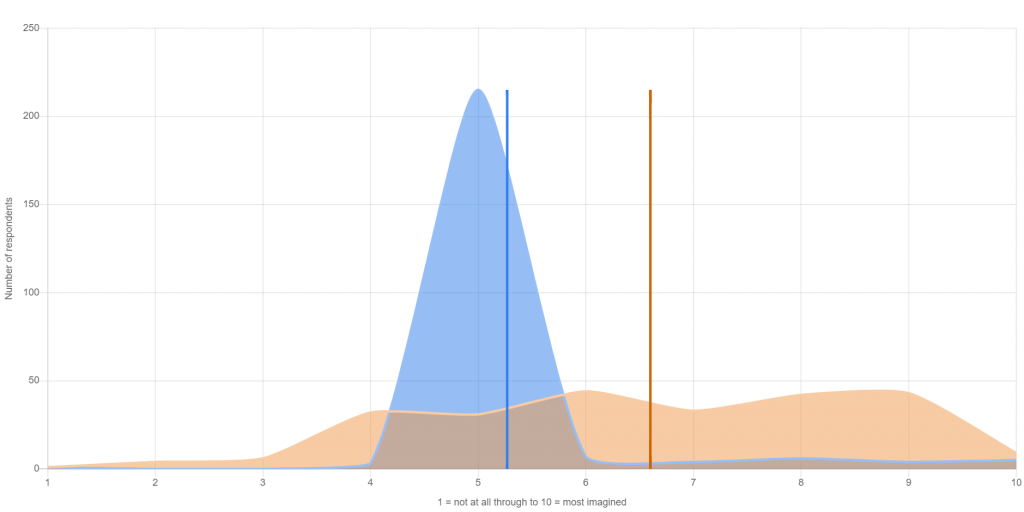Objective: Physical and/or mental wellbeing to be improved
Outcome: Physical and/or mental wellbeing is improved
Measure: Physical and/or mental wellbeing improved
Short description
By wellbeing we mean ones physical and mental health and the state of being comfortable, healthy and coping with life events and challenges.
Full description and underpinning theory
Full description
This outcome is about how engagement in cultural activity can impact on a person’s physical and/or mental wellbeing. This could include greater strength, fitness and body awareness arising from physical activities such as dance or circus training or mental wellbeing arising from the expressing oneself or engaging in creative activities either alone or with others.
Theory underpinning this outcome
The World Health Organisation’s constitution identifies that health is more than an absence of illness or impediment but rather is “a state of complete physical, mental and social well-being.” (WHO N.D) The Australian Bureau of Statistics identify that human well-being is constituted of a number of dimensions of which “time for and access to cultural and leisure activities”(Webster, Bode & Posselt, 2008. P5) is essential. The 2005 Mental Health Declaration for Europe (WHO Europe) describes mental health and well-being as crucial to an individuals’ ability to live a meaningful life, be creative and active citizens.
The amount of time engaged in the arts, or ‘the art dose’, may be important in obtaining mental health benefits.100 or more hours/year (i.e. two or more hours/week) of arts engagement may have the potential to enhance mental well-being in the general population (Davies et al, 2016).
Evidence that this outcome occurs
A set of physical values surrounds some arts experiences, particularly dance, but also any of the other arts experiences that engage the body, such as playing a musical instrument or working with clay. The body acquires new skills or achieves consonance with mind and spirit (Brown, 2004).
Positive correlations were found between cultural activities (art gallery visits, theater attendance, classical music attendance, pop music attendance, cultural festivals attendance, and reading books) and better health, stronger satisfaction with life in 16 out of 18 co-efficients (Hill Strategies Research, Canada, 2010).
People who engaged in 100 or more hours/year of arts engagement (i.e. two or more hours/week) reported significantly better mental well-being than other levels of engagement (Davies et al, 2016).
Economically disadvantaged preschoolers had lower levels of the stress hormone cortisol after they participated in intensive arts class (music, dance, or the visual arts), relative to cortisol levels after a homeroom class (Brown, Garnett, Anderson & Laurenceau, 2016).
Self-Book art therapy may help decrease emotional distress and enhance spiritual well-being in female cancer patients during active oncology treatment (Radl, Bradt, Vida, 2015).
Activities contributing to this outcome
Activities
As of April 2021, there were 22 activities in Takso selecting this outcome with 5 completed and evaluated. Types of activities undertaken to achieve this outcome include:
- Collection access,
- Creative recreational,
- Exhibitions: of arts and objects in all forms,
- Performances: performing arts of all forms.
Results
Over the 5 completed activities that addressed this outcome, 250 people responded to the evaluation question. On a scale of 1 to 10, with 1 being not at all and 10 the most imaginable, respondents reported an average pre activity level of 5.25 for this outcome and a post activity average of 6.6.
Physical and / or mental wellbeing improved
2 Activities / 250 responses / Pre activity average 5.25 / Post activity average 6.6

Evaluation measure
Physical and/or mental wellbeing
References
Brown, A. (2004). The Value Study: Rediscovering the Meaning and Value of Arts Participations. Hartford CT: Connecticut Commission on Culture and Tourism.
Brown, E., Garnett, M., Anderson, K., & Laurenceau, J-P. (2016). Can the Arts Get Under the Skin? Arts and Cortisol for Economically Disadvantaged Children, Child Development. DOI:10.1111/cdev.12652.
Davies, C. Knuiman, M., & Rosenberg, M. (2016). The art of being mentally healthy: a study to quantify the relationship between recreational arts engagement and mental well-being in the general population, BMC Public Health, 16(15), DOI: 10.1186/s12889-015-2672-7.
Radl, D. Bradt, J., & Vida, M. (2015). Final Research Report Effects of Art Therapy on Emotional Distress in Female Cancer Patients: A Randomized Controlled Trial. New York: National Endowment for the Arts.
Webster, A. Bode, G & Posselt, H (2008) Measuring wellbeing – the Australian Bureau of Statistics’ framework for social statistics. United Nations Secretariat Department of Economics and Social Affairs Statistics Division. retrieved from https://unstats.un.org/unsD/demographic/meetings/egm/NewYork_8-12Sep.2008/EGM%20Papers/Australia%20-%20Framework%20for%20social%20statistics.pdf
World Health Organisation (2005) Mental health declaration for Europe. WHO Europe. retrieved from http://www.euro.who.int/en/publications/policy-documents/mental-health-declaration-for-Europe
World Health Organisation (N.D.) Constitution. WHO retrieved from https://apps.who.int/gb/bd/pdf_files/BD_49th-en.pdf#page=6

